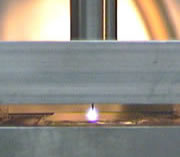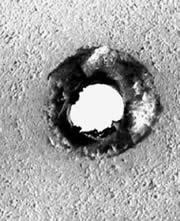Microwaves drill ceramicsSilent, dust-free drill melts
mini-holes in glass and concrete.
18 October 2002
PHILIP
BALL
 |
|
The microwave drill in
action.
Š Science/E.
Jerby |
| movie | |
A microwave drill can bore through materials such as
concrete and glass, silently and without creating dust.
By heating a target to nearly 2,000 ēC, the microwaves
soften it up enough for a small rod to be pushed
through.
"It should provide a low-cost solution for a variety
of needs," say the drill's inventors Eli Jerby and his
colleagues at Tel Aviv University in Israel1.
It can make holes between a millimetre and a centimetre
wide, and could find use, for example, in the production
of ceramic components for cars and planes, in building
construction and in geological engineering.
Using heat to cut and drill materials is nothing new.
Lasers are already widely used to make incisions or
holes as narrow as a thousandth of a millimetre. But
laser drilling is too expensive for many routine
engineering jobs, whereas the microwave drill costs
little more than a mechanical one.
 |
| A microwave-drilled hole
in alumina. |
| Š Science/E.
Jerby | | |
The drill bit is a needle-like antenna that emits
intense microwave radiation. The microwaves create a hot
spot around the bit, melting or softening the material
so that the bit can be pushed in.
But the drill can't bore through everything
effectively. Sapphire's melting point, for instance, is
too high. And steel conducts heat too well for a hot
spot to develop. But the device works fine on rocks and
concrete. In fact, the heat may even strengthen holes'
walls in ceramics by welding together the fine grains in
the material.
To use the drill, workers would have to be shielded
from the intense microwave radiation it produces. The
inventors claim that a simple shielding plate put in
front of the drill bit is enough to meet common safety
standards. | 

